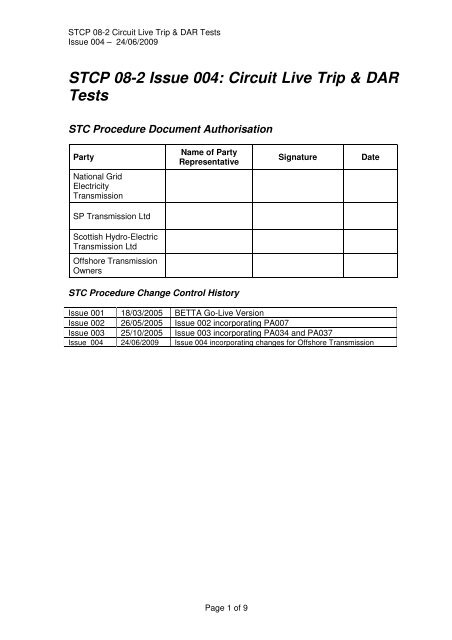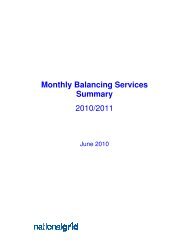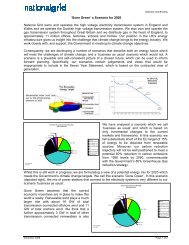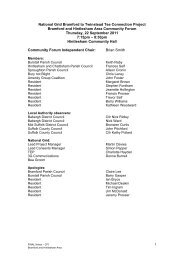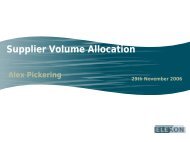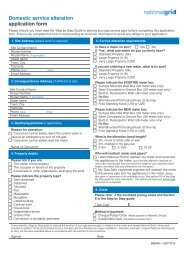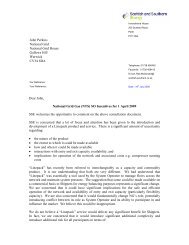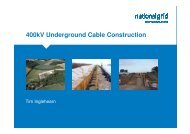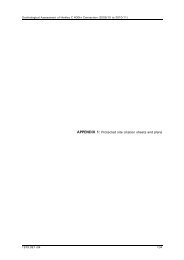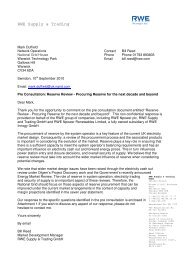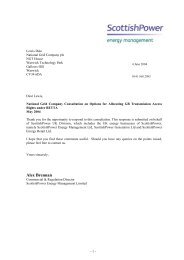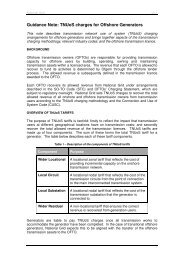STCP 08-2 Issue 004: Circuit Live Trip & DAR Tests - National Grid
STCP 08-2 Issue 004: Circuit Live Trip & DAR Tests - National Grid
STCP 08-2 Issue 004: Circuit Live Trip & DAR Tests - National Grid
You also want an ePaper? Increase the reach of your titles
YUMPU automatically turns print PDFs into web optimized ePapers that Google loves.
<strong>STCP</strong> <strong>08</strong>-2 <strong>Circuit</strong> <strong>Live</strong> <strong>Trip</strong> & <strong>DAR</strong> <strong>Tests</strong><br />
<strong>Issue</strong> <strong>004</strong> – 24/06/2009<br />
<strong>STCP</strong> <strong>08</strong>-2 <strong>Issue</strong> <strong>004</strong>: <strong>Circuit</strong> <strong>Live</strong> <strong>Trip</strong> & <strong>DAR</strong><br />
<strong>Tests</strong><br />
STC Procedure Document Authorisation<br />
Party<br />
<strong>National</strong> <strong>Grid</strong><br />
Electricity<br />
Transmission<br />
SP Transmission Ltd<br />
Scottish Hydro-Electric<br />
Transmission Ltd<br />
Offshore Transmission<br />
Owners<br />
Name of Party<br />
Representative<br />
STC Procedure Change Control History<br />
Page 1 of 9<br />
Signature Date<br />
<strong>Issue</strong> 001 18/03/2005 BETTA Go-<strong>Live</strong> Version<br />
<strong>Issue</strong> 002 26/05/2005 <strong>Issue</strong> 002 incorporating PA007<br />
<strong>Issue</strong> 003 25/10/2005 <strong>Issue</strong> 003 incorporating PA034 and PA037<br />
<strong>Issue</strong> <strong>004</strong> 24/06/2009 <strong>Issue</strong> <strong>004</strong> incorporating changes for Offshore Transmission
<strong>STCP</strong> <strong>08</strong>-2 <strong>Circuit</strong> <strong>Live</strong> <strong>Trip</strong> & <strong>DAR</strong> <strong>Tests</strong><br />
<strong>Issue</strong> <strong>004</strong> – 24/06/2009<br />
1 Introduction<br />
1.1 Scope<br />
1.1.1 This procedure describes the arrangements and processes across the NGET - TO<br />
interface for <strong>Circuit</strong> <strong>Live</strong> <strong>Trip</strong> and <strong>DAR</strong> <strong>Tests</strong> as part of maintenance activities within the<br />
licensed area of a TO. This does not include <strong>Circuit</strong> <strong>Live</strong> <strong>Trip</strong> and <strong>DAR</strong> <strong>Tests</strong> associated<br />
with commissioning or decommissioning activities, which are the subject of <strong>STCP</strong> 19-4<br />
Commissioning and Decommissioning.<br />
1.1.2 <strong>Circuit</strong> <strong>Live</strong> <strong>Trip</strong> and <strong>DAR</strong> <strong>Tests</strong> are complementary to the testing of Protection Apparatus<br />
and its associated electrical signalling that takes place when control of protection<br />
equipment is transferred to a TO under a Transmission Status Certificate (TSC).<br />
1.1.3 Any requests for <strong>Circuit</strong> <strong>Live</strong> <strong>Trip</strong> and <strong>DAR</strong> <strong>Tests</strong> will be made by the TO. It is not<br />
anticipated that NGET shall submit any requests under this procedure.<br />
1.1.4 The primary information exchange between NGET and TO for planning and implementing<br />
<strong>Circuit</strong> <strong>Live</strong> <strong>Trip</strong> and <strong>DAR</strong> <strong>Tests</strong> is set out in this procedure. Elements of information<br />
exchange mechanisms described in the STC, <strong>STCP</strong> 1-1 Operational Switching and<br />
<strong>STCP</strong>11-1 Outage Planning may also be used, where appropriate, in the planning and<br />
operation of <strong>Circuit</strong> <strong>Live</strong> <strong>Trip</strong> and <strong>DAR</strong> <strong>Tests</strong>.<br />
1.1.5 This procedure applies to NGET and each TO where, for the purpose of this document,<br />
the TOs are:<br />
• SPT;<br />
• SHETL; and<br />
• All Offshore Transmission Licence holders as appointed by OFGEM<br />
In the event that specific conditions or exceptions are made in the document relating to an<br />
Onshore TO or Offshore TO these will be prefixed appropriately.<br />
1.2 Objectives<br />
1.2.1 This procedure specifies the following:<br />
• the responsibilities of NGET and the TO(s) in relation to <strong>Circuit</strong> <strong>Live</strong> <strong>Trip</strong> and <strong>DAR</strong><br />
<strong>Tests</strong>;<br />
• the requirements for exchange of information across the NGET - TO interface;<br />
• the means of communication to be used across the NGET - TO interface.<br />
1.2.2 It is designed to enable the Parties to discharge their responsibilities under the STC and<br />
to ensure that responsibilities are clear.<br />
2 Key Definitions<br />
2.1 For the purposes of <strong>STCP</strong> 8-2:<br />
2.1.1 <strong>Circuit</strong> Breaker Fail means Protection Apparatus designed to operate as back-up<br />
Protection on the failure of a <strong>Circuit</strong> Breaker to trip following receipt of a trip command<br />
from an associated tripping relay.<br />
2.1.2 <strong>Circuit</strong> <strong>Live</strong> <strong>Trip</strong> and <strong>DAR</strong> <strong>Tests</strong> means the planned switch out of Plant and Apparatus<br />
by Protection Apparatus, and restoration of that Plant and Apparatus in whole or in part by<br />
automatic or manual means.<br />
2.1.3 <strong>Circuit</strong> Breaker means an item of equipment designed to switch electric plant into and<br />
out of service, rated to operate under fault conditions.<br />
2.1.4 Operational Intertripping Scheme means a scheme involving the automatic tripping of<br />
circuit breakers to prevent abnormal system conditions occurring.<br />
Page 2 of 9
<strong>STCP</strong> <strong>08</strong>-2 <strong>Circuit</strong> <strong>Live</strong> <strong>Trip</strong> & <strong>DAR</strong> <strong>Tests</strong><br />
<strong>Issue</strong> <strong>004</strong> – 24/06/2009<br />
2.1.5 Operational Effect is as defined in the <strong>Grid</strong> Code as at the Code Effective Date and for<br />
purposes of this <strong>STCP</strong> only, not as defined in the STC.<br />
3 Process<br />
3.1 General<br />
3.1.1 Whenever possible <strong>Circuit</strong> <strong>Live</strong> <strong>Trip</strong> and <strong>DAR</strong> <strong>Tests</strong> should be planned in advance but this<br />
does not exclude the possibility of agreeing tests at shorter notice, including Control<br />
Phase timescales.<br />
3.1.2 <strong>Circuit</strong> <strong>Live</strong> <strong>Trip</strong> and <strong>DAR</strong> <strong>Tests</strong> shall be planned and carried out by the affected Parties<br />
such that, with the exception of the Plant and Apparatus subject to the test, there is<br />
minimal impact on the <strong>National</strong> Electricity Transmission System.<br />
3.1.3 NGET shall remain responsible for the operational management of the <strong>National</strong> Electricity<br />
Transmission System during any testing.<br />
3.1.4 The TO shall be responsible for managing the <strong>Tests</strong> programme in accordance with the<br />
requirements of this procedure.<br />
3.2 Planning Process<br />
3.2.1 The TO shall submit all Outage requests for the <strong>Circuit</strong> <strong>Live</strong> <strong>Trip</strong> and <strong>DAR</strong> <strong>Tests</strong> in<br />
accordance with <strong>STCP</strong> 11-1 Outage Planning.<br />
3.2.2 Any request for such an Outage shall be flagged as ‘<strong>Circuit</strong> <strong>Live</strong> <strong>Trip</strong> & <strong>DAR</strong> <strong>Tests</strong>’, where<br />
the circuit will be fully restored by <strong>DAR</strong> action, and flagged as an 'in-service' Outage<br />
request. Although in principle these <strong>Circuit</strong> <strong>Live</strong> <strong>Trip</strong> and <strong>DAR</strong> Test Outages do not form<br />
part of security analysis, the Operational Effect of a <strong>DAR</strong> sequence failure or the need to<br />
restore the circuit manually shall be considered as part of the Outage planning process.<br />
3.2.3 Any work requiring either auto isolation of some part of the Plant and Apparatus involved<br />
in the <strong>Tests</strong>, or Plant and Apparatus to remain out of service as a result of the testing,<br />
shall be separately requested as an Outage in accordance with <strong>STCP</strong> 11-1 Outage<br />
Planning and will be considered in security analysis. Such Plant and Apparatus will be<br />
returned to service in accordance with <strong>STCP</strong> 1-1 Operational Switching, as appropriate.<br />
3.2.4 Plant and Apparatus to be switched out of service by operation of Protection Apparatus as<br />
part of planned maintenance work will be treated as an Outage request under <strong>STCP</strong> 11-1<br />
Outage Planning and included in security studies on that basis, with the Outage booking<br />
commented with 'Switch out by protection'.<br />
3.2.5 Initiation of a <strong>Circuit</strong> <strong>Live</strong> <strong>Trip</strong> and <strong>DAR</strong> Test will normally be by operation of Protection<br />
Apparatus. If <strong>Circuit</strong> <strong>Live</strong> <strong>Trip</strong> and <strong>DAR</strong> <strong>Tests</strong> are planned on Plant and Apparatus with no<br />
associated <strong>DAR</strong> facility, the resource and time needed to restore that Plant and<br />
Apparatus to service by manual switching shall be considered for operational impact as<br />
part of the planning liaison.<br />
3.2.6 Consideration shall be given by NGET and the TO, when scheduling <strong>Circuit</strong> <strong>Live</strong> <strong>Trip</strong> and<br />
<strong>DAR</strong> <strong>Tests</strong>, to the possible interaction with <strong>Circuit</strong> Breaker Fail Protection systems,<br />
voltage changes and automatic switching systems. Appendix B provides further<br />
information and guidance.<br />
3.2.7 As part of the planning of <strong>Circuit</strong> <strong>Live</strong> <strong>Trip</strong> and <strong>DAR</strong> <strong>Tests</strong> on cross TO boundary circuits,<br />
liaison and agreement shall take place between the TOs involved. The requesting TO<br />
shall take the lead in co-ordinating discussions and reaching agreement with the other<br />
affected TO(s). The requesting TO shall be responsible for liasing with NGET regarding<br />
such outcome of discussions.<br />
3.2.8 No <strong>Circuit</strong> <strong>Live</strong> <strong>Trip</strong> and <strong>DAR</strong> <strong>Tests</strong> will take place on circuits where the <strong>Tests</strong> would result<br />
in operation of an Operational Intertripping Scheme unless this is the stated purpose of<br />
the <strong>Tests</strong> and agreement for the <strong>Tests</strong> has been reached with all affected parties prior to<br />
the <strong>Tests</strong>.<br />
Page 3 of 9
<strong>STCP</strong> <strong>08</strong>-2 <strong>Circuit</strong> <strong>Live</strong> <strong>Trip</strong> & <strong>DAR</strong> <strong>Tests</strong><br />
<strong>Issue</strong> <strong>004</strong> – 24/06/2009<br />
3.2.9 NGET shall be responsible for obtaining the agreement of an affected User or affected TO<br />
to <strong>Circuit</strong> <strong>Live</strong> <strong>Trip</strong> and <strong>DAR</strong> <strong>Tests</strong> as soon as reasonably practicable. <strong>Tests</strong> will only be<br />
carried out if and when agreement for the <strong>Tests</strong> has been reached with the affected User<br />
or affected TO.<br />
3.3 <strong>Tests</strong> programmes<br />
3.3.1 Where more than a single <strong>Circuit</strong> <strong>Live</strong> <strong>Trip</strong> and <strong>DAR</strong> Test is proposed on a circuit a written<br />
programme of <strong>Tests</strong> shall be provided by the TO unless agreed otherwise by NGET. The<br />
<strong>Tests</strong> programme shall detail the equipment involved, the sequence of <strong>Tests</strong> and any<br />
Operational Effects (or possible Operational Effects). Such <strong>Circuit</strong> <strong>Live</strong> <strong>Trip</strong> and <strong>DAR</strong><br />
<strong>Tests</strong> will normally be planned to take place at the start or completion of an Outage of the<br />
circuit.<br />
3.3.2 The TO will use reasonable endeavours to provide the proposed programme of <strong>Circuit</strong><br />
<strong>Live</strong> <strong>Trip</strong> and <strong>DAR</strong> <strong>Tests</strong> to NGET in the Operational Planning Phase, normally a<br />
minimum of 6 weeks prior to the date of testing. It is accepted, however that such <strong>Circuit</strong><br />
<strong>Live</strong> <strong>Trip</strong> and <strong>DAR</strong> <strong>Tests</strong> may be requested by the TO at shorter notice.<br />
3.3.3 NGET and the TO may agree break points in the <strong>Tests</strong> programme such that the TO can<br />
complete sections of the <strong>Tests</strong> programme without further reference to NGET.<br />
3.3.4 NGET will assess the implications of the proposed <strong>Tests</strong> programme and liase with each<br />
affected User and affected TO, seek their agreement to the <strong>Tests</strong> programme and collate<br />
and co-ordinate the response to the TO as soon as reasonably practicable.<br />
3.3.5 If the <strong>Tests</strong> programme is not acceptable to NGET, an affected User or affected TO then<br />
NGET shall refuse the submitted <strong>Tests</strong> programme and will inform the TO as soon as<br />
reasonably practicable. The TO may choose to revise and re-submit the <strong>Tests</strong> programme<br />
to NGET or initiate a dispute. Any revised <strong>Tests</strong> programme will be assessed by NGET,<br />
an affected TO and affected User in accordance with this procedure.<br />
3.3.6 The TO will use reasonable endeavours to ensure the agreed <strong>Tests</strong> programme is made<br />
available to NGET at least 5 Business Days in advance of testing.<br />
3.4 Operational Process<br />
3.4.1 NGET shall be responsible for operational liaison in order to obtain agreement from an<br />
affected User or affected TO for the <strong>Tests</strong> to proceed in the Control Phase. Where a <strong>Tests</strong><br />
programme is used NGET shall inform each affected User and affected TO prior to the<br />
start of the <strong>Tests</strong> if NGET intends to allow the TO to become the operational contact for<br />
the <strong>Tests</strong>.<br />
3.4.2 <strong>Tests</strong> shall be carried out in accordance with the requirements of <strong>STCP</strong> 1-1 Operational<br />
Switching and the <strong>Tests</strong> programme if appropriate for Plant and Apparatus under NGET<br />
operational control (not released to the TO) and will normally be carried out under a verbal<br />
Switching Method agreement recorded by NGET and the TO.<br />
3.4.3 When NGET has given permission for the TO to carry out <strong>Circuit</strong> <strong>Live</strong> <strong>Trip</strong> and <strong>DAR</strong> <strong>Tests</strong><br />
the TO shall contact affected Users and advise that the TO has become the point of<br />
operational contact for the <strong>Tests</strong> programme and that the test will shortly commence.<br />
3.4.4 Prior to <strong>Circuit</strong> <strong>Live</strong> <strong>Trip</strong> and <strong>DAR</strong> <strong>Tests</strong> on cross TO boundary circuits, operational liaison<br />
and agreement shall take place between the TOs involved. The requesting TO shall take<br />
the lead in co-ordinating discussions and reaching agreement with the other affected<br />
TO(s). The requesting TO shall be responsible for liasing with NGET regarding the<br />
outcome of such discussions.<br />
3.4.5 In the event of failure of <strong>Tests</strong> (e.g. failure of a circuit breaker to re-close in programmed<br />
sequence) the TO shall contact NGET as soon as reasonably practicable, and seek<br />
agreement to vary the <strong>Tests</strong> programme to allow restoration of the circuit and re-testing<br />
as appropriate.<br />
3.4.6 If during <strong>Tests</strong>, an unexpected alarm or event occurs that the relevant TO believes has or<br />
may have an Operational Effect on the proposed <strong>Tests</strong> programme, the TO shall contact<br />
NGET as soon as reasonably practicable to discuss the implications of the unexpected<br />
alarm or event. Parties shall use reasonable endeavours to agree the subsequent actions<br />
to be followed in a timely manner.<br />
Page 4 of 9
<strong>STCP</strong> <strong>08</strong>-2 <strong>Circuit</strong> <strong>Live</strong> <strong>Trip</strong> & <strong>DAR</strong> <strong>Tests</strong><br />
<strong>Issue</strong> <strong>004</strong> – 24/06/2009<br />
3.4.7 If during <strong>Tests</strong>, NGET becomes aware of any reason to stop or delay the <strong>Tests</strong> they shall<br />
contact the TO as soon as reasonably practicable to discuss and agree any action that<br />
may be required.<br />
Page 5 of 9
<strong>STCP</strong> <strong>08</strong>-2 <strong>Circuit</strong> <strong>Live</strong> <strong>Trip</strong> & <strong>DAR</strong> <strong>Tests</strong><br />
<strong>Issue</strong> <strong>004</strong> – 24/06/2009<br />
Appendix A: Process Diagrams<br />
Note that the Process Diagrams shown in this Appendix A are for information only. In the<br />
event of any contradiction between the process represented in this appendix and the<br />
process described elsewhere in this <strong>STCP</strong>, then the text elsewhere in this <strong>STCP</strong> shall<br />
prevail.<br />
S T C P 8 -2 C irc u it L iv e T rip & D A R T e s tin g<br />
E x te rn a l NGET T O<br />
A f f e c t e d U s e r s /<br />
a ffe c te d T O<br />
c o n ta c te d<br />
A g r e e t o<br />
P r o te c ti o n<br />
T e s t s<br />
?<br />
N o<br />
E n d<br />
Y e s<br />
Page 6 of 9<br />
N G E T re c e iv e s<br />
r e q u e s t<br />
I s T e s t s<br />
p r o g r a m m e<br />
r e q u i r e d ?<br />
N o<br />
A n y<br />
a u to is o la tio n<br />
in v o lv e d ?<br />
N o<br />
I s<br />
t h e r e U s e r<br />
i m p a c t<br />
?<br />
Y e s<br />
2 .1 1 N G E T c o -o rd in a te s<br />
w i t h a f fe c te d U s e r s o r<br />
a ffe c te d T O a n y te s tin g<br />
th a t c o u l d a ffe c t th e ir<br />
e q u i p m e n t o r n e t w o r k<br />
N G E T a p p ro v e s<br />
O u t a g e r e q u e s t ( s )<br />
a n d T e s t s<br />
p r o g r a m m e<br />
?<br />
Y e s<br />
N o<br />
O u ta g e (s ) i n c l u d e d i n T O G A<br />
d a t a b a s e<br />
R e q u e s t s s t a te :<br />
- C irc u it L iv e T rip & D A R te s tin g<br />
- c irc u it in v o lv e d<br />
- 'i n - s e r v i c e ' b o o k i n g s<br />
Y e s<br />
Y e s<br />
N G E T /T O c o n s id e r<br />
r e s to ra tio n im p l ic a tio n s<br />
N o<br />
T O s u b m i ts a n O u ta g e<br />
r e q u e s t/ p r o p o s a l fo r C ir c u it<br />
L iv e T rip & D A R (in<br />
a c c o rd a n c e w ith S T C P 1 1 -1<br />
O u ta g e P la n n in g )<br />
T O s u b m i t s<br />
p r o g r a m m e<br />
T O s u b m its O u ta g e<br />
r e q u e s t f o r a u t o<br />
is o la te d P la n t a n d<br />
A p p a r a t u s<br />
T O id e n tifie s P la n t<br />
a n d A p p a r a tu s to b e<br />
t r i p p e d b u t w i t h o u t<br />
D A R fa c ilitie s<br />
T O m a y c h o o s e to<br />
r e v i s e a n d r e -<br />
s u b m i t O u t a g e<br />
r e q u e s t a n d / o r<br />
T e s t s p r o g r a m m e<br />
E n d<br />
D i s p u te r e s o l u t i o n p r o c e s s<br />
m a y b e i n itia te d<br />
G o to B<br />
o n P a g e 2
<strong>STCP</strong> <strong>08</strong>-2 <strong>Circuit</strong> <strong>Live</strong> <strong>Trip</strong> & <strong>DAR</strong> <strong>Tests</strong><br />
<strong>Issue</strong> <strong>004</strong> – 24/06/2009<br />
Page 7 of 9
<strong>STCP</strong> <strong>08</strong>-2 <strong>Circuit</strong> <strong>Live</strong> <strong>Trip</strong> & <strong>DAR</strong> <strong>Tests</strong><br />
<strong>Issue</strong> <strong>004</strong> – 24/06/2009<br />
Appendix B: <strong>Issue</strong>s to be considered for <strong>Circuit</strong> <strong>Live</strong> <strong>Trip</strong> and<br />
<strong>DAR</strong> <strong>Tests</strong><br />
B.1 Voltage Criteria<br />
B1.1 Guidance on the acceptable transient voltage change for planned <strong>Circuit</strong> <strong>Live</strong> <strong>Trip</strong> and<br />
<strong>DAR</strong> <strong>Tests</strong> is contained in the GB SQSS.<br />
B1.2 Consideration shall be given as to the control arrangements available (e.g. telecommand<br />
of tap change controls) to ensure Good Industry Practice can be followed to ensure the voltage<br />
change is minimised by bringing equipment associated with the testing to minimum MVAr<br />
import/export conditions.<br />
B.2 <strong>Circuit</strong> Restrictions<br />
B2.1 <strong>Trip</strong> testing shall normally take place with ‘<strong>Circuit</strong> Breaker Fail’ (‘CBF’) protection in<br />
service where installed to assist in the rapid clearance of a fault.<br />
B2.2 For circuits with charging currents that exceed 80% of ‘CBF’ current check settings, there<br />
is a risk that if the circuit breaker fails to open a back trip could be initiated. Where NGET<br />
conclude the consequences of this are acceptable, the ‘CBF’ can remain in service. Where it is<br />
not acceptable for operational reasons (e.g. loss of supply would result) the ‘CBF’ protection can<br />
be switched out at the relevant end provided Intertripping exists to ensure remote end clearance<br />
of genuine faults.<br />
B2.3 The TO shall identify those circuits where the charging current is likely to exceed 80% of<br />
the ‘<strong>Circuit</strong> Breaker Fail’ current check setting.<br />
B2.4 The operation of auto-reclose schemes, during <strong>Circuit</strong> <strong>Live</strong> <strong>Trip</strong> <strong>Tests</strong> of circuits, may<br />
result in circuits returning under <strong>DAR</strong> which could bring the site above the Normal Capability Limit<br />
of the switchgear. In such cases <strong>Tests</strong> should only be carried out where agreement has been<br />
reached on fault level management. Further guidance is available in <strong>STCP</strong> 4-4 'Provision of<br />
Operational Information'. Different auto-reclose schemes deal with this temporary potential over<br />
stressing in differing ways; some can configure the site to the pre-fault arrangement automatically;<br />
others require manual intervention.<br />
B2.5 The TO will identify those circuits associated with sites where auto-reclose schemes may<br />
result in temporary overstressing of switchgear and agree fault level management measures to be<br />
implemented during the <strong>Tests</strong>.<br />
B2.6 Some circuits on the transmission system are monitored by generation or demand<br />
disconnection schemes. <strong>Circuit</strong> <strong>Live</strong> <strong>Trip</strong> <strong>Tests</strong> shall not be undertaken on circuits which, if<br />
tripped, would cause subsequent tripping of generator or other circuits, unless this is the specific<br />
intention of the <strong>Tests</strong> and all affected parties have agreed the <strong>Tests</strong> may take place.<br />
B.3 Other Considerations<br />
B3.1 Consideration shall be given to the consequences of <strong>DAR</strong> failure and the means to<br />
ensure rapid restoration of a circuit by other means. This may involve the TO ensuring<br />
attendance can be arranged at sites involved within an agreed time period.<br />
B3.2 <strong>Circuit</strong> <strong>Live</strong> <strong>Trip</strong> and <strong>DAR</strong> <strong>Tests</strong> should not normally take place during periods of<br />
predicted or actual local adverse weather conditions.<br />
B3.3 Consideration shall be given by the TO and NGET to existing Operational Capability<br />
Limits affecting equipment when evaluating their suitability for <strong>Circuit</strong> <strong>Live</strong> <strong>Trip</strong> and <strong>DAR</strong> <strong>Tests</strong>.<br />
Page 8 of 9
<strong>STCP</strong> <strong>08</strong>-2 <strong>Circuit</strong> <strong>Live</strong> <strong>Trip</strong> & <strong>DAR</strong> <strong>Tests</strong><br />
<strong>Issue</strong> <strong>004</strong> – 24/06/2009<br />
Appendix C: Abbreviations & Definitions<br />
Abbreviations<br />
<strong>DAR</strong> Delayed Auto Reclose<br />
SHETL Scottish Hydro Electric Transmission Ltd<br />
SPT SP Transmission Ltd<br />
STC System Operator –Transmission Owner Code<br />
<strong>STCP</strong> System Operator –Transmission Owner Code Procedure<br />
TO Transmission Owner<br />
Definitions<br />
STC definitions used:<br />
Apparatus<br />
Business Day<br />
Dispute<br />
<strong>National</strong> Electricity Transmission System<br />
Good Industry Practice<br />
NGET<br />
Normal Capability Limit<br />
Operational Capability Limit<br />
Outage<br />
<strong>Tests</strong><br />
Party<br />
Plant<br />
Protection<br />
User<br />
<strong>Grid</strong> Code definitions used:<br />
Apparatus<br />
Control Phase<br />
Operational Effect<br />
Operational Intertripping<br />
Operational Planning Phase<br />
Protection Apparatus<br />
Definition used from other <strong>STCP</strong>s:<br />
Transmission Status Certificate <strong>STCP</strong>1-1: Operational Switching<br />
Switching Method <strong>STCP</strong>1-1: Operational Switching<br />
Page 9 of 9


